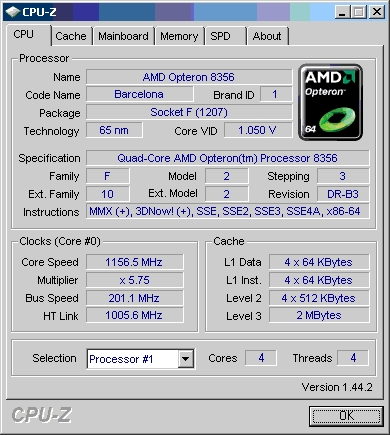Power
Both our AMD and Intel systems found a home in exactly the same chassis, powered by exactly the same power supply (Supermicro 1000W w/PFC Model PWS-1K01-1R). The Xeon 5472 results are not directly comparable as it uses a different PSU.
| System Power Requirements | ||||
| CPU configuration | CINEBENCH 10 64-bit | Idle | Idle+ Powernow! / Speedstep | Spejbb2005, CPU load at 100% |
| Quad Opteron 8356 | 537 | 303 | 289 | 530 |
| Dual Opteron 8356 16 GB | 340 | 215 | 208 | 337 |
| Quad Xeon 7350 | 702 | 462 | 381 | 701 |
| Quad Xeon 7330 | 536 | 375 | 355 | 536 |
| Dual Xeon 7350 | 500 | 380 | 339 | 499 |
| Dual Xeon 7330 | 416 | 359 | 335 | 410 |
| Dual Xeon 5472* | 349* | n/a | 251* | 345* |
When it comes to full load, the Intel Xeon 7330 and AMD 8356 based server consume about the same. The AMD server consumes about 66W less when it is running idle. As always, the FB-DIMMs are the problem. We could not test the dual Opteron with 16 DIMMs (it has only eight slots available with two CPUs), but the difference between a quad and a dual Opteron 8356 is almost 200W. Assume that the eight DIMMs of DDR2 are good for about 50W. In that case, two Opteron 8356 are good for 150W of extra power. In the case of the Xeon MP 7330, we see that taking away two Xeons lowers the power consumption about 120W, or 60W per CPU. If you consider the power usage of the memory controller, the AMD and Intel CPUs are in the same ballpark.
We were very
surprised to see so little difference between the idle power of the Opteron 8356
at 2.3GHz, and the power consumed when PowerNow! throttles the CPU down to half
its speed. AMD implemented advanced clock gating in the newest Opteron: big blocks
like the FPU can be turned off, but it is possible to turn off many small sections
too. Even the memory controller can turn off both the read and write logic. The
result is that we measured that PowerNow! makes only a 3.5W difference per core
both in dual and quad-core configurations. According to AMD, PowerNow! provides
at most between 1% and 80% benefit at load (yes, that's a big range). The other
reason might be that the voltage drop from 2.3GHz to 1.15GHz is rather modest: from
1.15v at 2.3GHz to 1.05v at 1.15GHz. Intel Xeon MP 7330 reduces it's voltage from 1.26V at 2.4 GHz to 1.13V at 1.6 GHz.

This might also explain the small difference we have seen. In the table below we compare 100% CPU load (full load) with "lowest". With lowest we refer to the SpeedStep/PowerNow! enable power consumption numbers.
| System Power Savings | ||||
| CPU configuration | Full load vs lowest | Percentage Saving | Idle versus lowest | Percentage Saving |
| Quad Opteron 8356 | 241 | 45% | 14 | 5% |
| Dual Opteron 8356 16 GB | 129 | 38% | 7 | 3% |
| Quad Xeon 7350 | 320 | 46% | 81 | 18% |
| Quad Xeon 7330 | 181 | 34% | 20 | 5% |
| Dual Xeon 7350 | 160 | 32% | 41 | 11% |
| Dual Xeon 7330 | 75 | 18% | 24 | 7% |
As the CPUs in the AMD system are the ones which consume the most, more power is saved between full load and idle. It also seems that the AMD's clock gating is a bit more advanced than the Intel's 65nm CPU family.










0 Comments
View All Comments